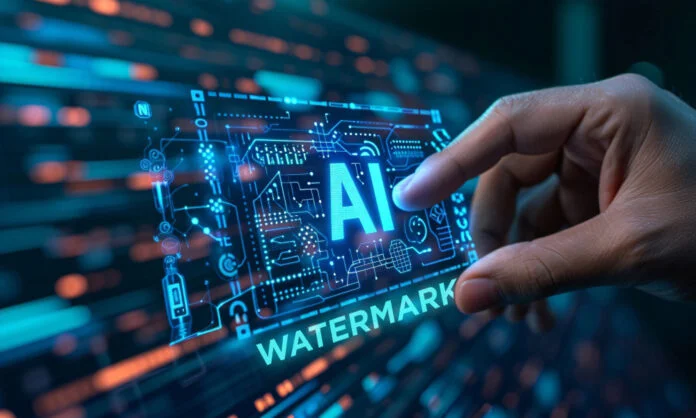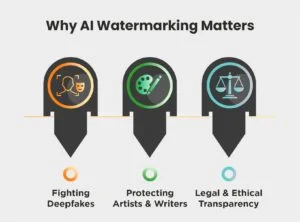Can You Spot the Fake? Why AI Watermarking is Changing the Game?
You are scrolling through your feed, and you see a viral image of a celebrity in an outrageous outfit. The comments are going wild. But here’s the unsettling truth, there’s a 50% chance it was completely generated by AI.
This isn’t just about celebrity gossip. As AI tools become indistinguishable from reality, we are facing a growing crisis of digital trust. Fake product reviews, fabricated news articles, and even fraudulent business communications are slipping through unchecked.
That’s where AI watermarking steps in, the digital equivalent of a “Made by AI” label. It’s not some futuristic concept. It is becoming an essential infrastructure for our online world, helping journalists verify sources and consumers identify authentic content. Let’s understand the concept in detail.
What is AI Watermarking?
AI or digital watermarking is like an invisible stamp on digital content that says, “This was made by AI.” Just like artists sign their paintings, digital watermarking helps identify text, images, audio, and videos created by machines.
Why do We Need It?
- Prevents Misinformation: Stops fake AI-generated news or deepfakes from spreading.
- Protects Copyright: Helps creators know if their work was used to train AI.
- Ensures Transparency: It helps people understand whether they are interacting with AI-made content or not.
Without digital watermarking, it’s easy for misleading content to go viral without anyone realizing it’s fake.
How Does AI Watermarking Work?
AI watermarking embeds hidden or visible markers in AI-generated content to verify its origin. The process has two key steps:
- Embedding: During content creation, the AI subtly alters text (word patterns), images (pixel changes), or audio (frequency shifts) to include a digital signature. These marks are designed to be hard to remove without detection.
- Detection: Special tools scan content for these markers. Text is analyzed for unusual phrasing, images for pixel patterns, and audio for frequency changes. Some methods use encryption for extra security.
Different Types of AI Watermarking
Majorly there are two types of AI watermarking, they are:
- Visible AI Watermarking: Easily recognizable marks on images or videos. Such as logos or text overlays.
Example: Open AI’s DALL-E2 uses visible watermarks composed of colored blocks. - Imperceptible Watermarks (Invisible Watermark): It is not noticeable to human eyes. It is only detected by algorithms.
Example: Slight modifications in pixel values or text structure.
Why AI Watermarking Matters Now More Than Ever
With AI-generated content everywhere, watermarking helps in real-world scenarios:
Fighting Deepfakes
Fake videos of politicians or celebrities can cause chaos. Digital watermarking helps platforms quickly spot and remove them.
Protecting Artists & Writers
If an AI generates a painting similar to a real artist’s work, a watermark can prove it wasn’t human-made.
Legal & Ethical Transparency
Governments (like the EU’s AI Act) are pushing for AI content to be labeled. Watermarking makes compliance easier.
Challenges in AI Watermarking
It’s not a perfect system yet. Some big hurdles include:
- Removal & Tampering: Hackers can erase or alter watermarks. For example, cropping out a “made by AI” label from an image.
- False Positives/Negatives: Sometimes, human content gets flagged as AI (and vice versa).
- No Universal Standard: Different companies use different watermarking methods, making detection inconsistent.
What’s Next for AI Watermarking?
The future looks promising:
- Better Detection Tools: Like Google’s SynthID, improving watermark accuracy.
- Legal Requirements: More laws forcing AI companies to watermark content.
- Public Awareness: People learn to check for watermarks before sharing content.
Wrapping Up
AI watermarking is a small but powerful tool in keeping the digital world honest. As AI gets smarter, we need smarter ways to track it. Whether you are a creator, consumer, or tech enthusiast, understanding digital watermarking helps you navigate the future of digital content safety.
To get more AI insights, visit YourTechDiet!
FAQ
- Can AI watermarks be faked?
Answer: Yes, but advanced systems (like cryptographic watermarks) are making it harder.
- Do all AI tools add watermarks?
Answer: Not yet, but big players (Google, OpenAI, Adobe) are adopting them.
- How can I check if something has an AI watermark?
Answer: Tools like Hive AI Detector or Adobe’s Content Credentials can scan for watermarks.
You Might Like:
Top 7 AI Tools for Business
What Role Can AI Play in the Brainstorming Process?


